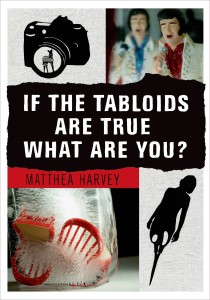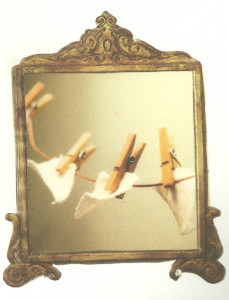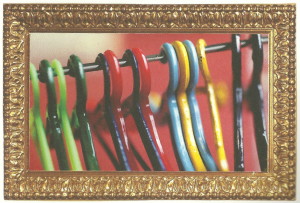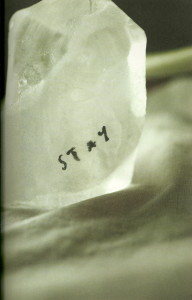What We’re Reading: If the Tabloids Are True What Are You?

 If the Tabloids Are True What Are You? by Matthea Harvey (Graywolf Press, 2014)
If the Tabloids Are True What Are You? by Matthea Harvey (Graywolf Press, 2014)
Matthea Harvey is a rare poet whose work is at once technically sound and formally innovative, original, and moving. If the Tabloids Are True What Are You is her fourth collection and all of her themes and obsessions are on display, careening into one another to create a hybrid work featuring a cast of hybrid characters. The book itself is lovely to look at, filled with original visual art that is synthesized beautifully and seamlessly with the text.
Visual art isn’t new for Harvey: she created the cover image for her 2007 collection Modern Life (Graywolf, 2007), collaborated with painter Amy Jean Porter on a collection of erasures called Of Lamb in 2011 (McSweeney’s), and her sister is the visual artist Ellen Harvey. The difference between her previous work and Tabloids is how closely tied the art and text are. A series of nine poems only have images as titles:


Another four have text cut into silhouettes as titles:

One piece,

(d)evolves beyond even those and features no text, except the word “stay” in the title.
A poem early in Tabloids, “Michelin Man Possessed by William Shakespeare,” could be read as an ars poetica of hybridity. “I’ve taken many forms over the years, / but this may be the strangest one,” this perfect Elizabethan sonnet begins. Harvey loves taking new forms, inventing impossible or impractical machines. Indeed, her second collection is called Sad Little Breathing Machine (Graywolf, 2004). The final couplet of “Michelin Man Possessed by William Shakespeare” is most apt when talking about Harvey’s work:
Make us a man, or make us a machine—
But do not leave us trapped here in-between.
Whether Harvey fears or loves liminal spaces is hard to know, but she spends a lot of time in them. In only the first 20 pages, Harvey combines visual art with text to create a new form, which takes for its subject a composite being, the mermaid–part human, part fish. The text of these pieces are prose poems, a hybrid form itself.
The standout piece in Tabloids is the long closing piece, “Telettrofono,” a mixture of history, poetry, visual art, and, in one iteration, sound. The piece “was originally created as a soundwalk with sound artist Justin Bennett for Stillspotting NYC: Staten Island.” In this masterpiece, Harvey’s obsessions spiral into and around one another. Using the life of inventor Anonio Meucci, Harvey crafts for him a mythology, using his real life achievements to build a world where mermaids come to land for the love of sound. In Harvey’s narrative, Meucci’s mermaid wife, Esterre, inspires his inventions. The small details that make the piece:
PRESET PATENT MODE
MARINE TELEPHONE: WAY FOR THOSE THAT WORK UNDERWATER CALLED DIVERS HELPED BY THE TELEPHONE TO SPEAK ABOVE WATER (PATENT STILL PENDING AT TIME OF DEATH)
PRESET MARINE TELEPHONE MODE (MERMAID CHORUS)
Calling us “divers
is probably a good idea.
The fusion of invention, history, hybrid creatures, visual art, and text is remarkable and poignant.
Despite all of the crossbred forms, the poems collected here demonstrate Harvey’s command of technique. As off-kilter as her subjects can be, she still knows how to craft a poem that is surprising and complete. The sonnet mentioned earlier is impressive on its own, but other poems feature well placed revelations that drive the poems forward. The opening “Mermaid” poems create a new mythology of mermaids:
“At least she’s all mermaid: never gets tired of swimming, hates the thought of socks.”
(“The Straightforward Mermaid”)
“These days, her sisters trail cruise ships, hunting for orange prescription bottles that might be bobbing in the ship’s wake.”
(“The Impatient Mermaid”)
“Mer-funerals are the worst since, poof, the merfolk just morph into seafoam.”
(“The Morbid Mermaid”)
Because, of course mermaids dissolve into seafoam when they die. Of course they’re addicted to lost Xanax and hate socks. Again, it’s the small details that elicit small gasps and surprised laughs that make these poems so exciting.
Whether Harvey planned it or not, she has been building up to If the Tabloids Are True What Are You? in all of her previous work. It’s still jarring and humbling to see how well deployed her craft is in this book. It makes me wonder what she’ll do next, where she can go from here. Based on her previous work, it’s sure to be a surprise.
What other writers currently working are at the top of their game right now?





